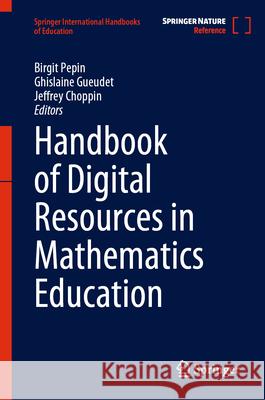Handbook of Digital Resources in Mathematics Education » książka



Handbook of Digital Resources in Mathematics Education
ISBN-13: 9783031456664 / Angielski
Handbook of Digital Resources in Mathematics Education
ISBN-13: 9783031456664 / Angielski
(netto: 1529,96 VAT: 5%)
Najniższa cena z 30 dni: 1465,09
ok. 22 dni roboczych.
Darmowa dostawa!
Section 1: Introduction
1. Introduction to the handbook
Section 2: Methodological and Theoretical Issues for Researching Digital Resources in Mathematics Education
1. Advancing mathematics education on digital resources: a reciprocity between theory, methodology, and design
2. A pragmatic approach to theorizing interdisciplinary design research on interactive math learning systems: The case of a multimodal algebra learning system with tangible user interfaces
3. Networking of theories: An approach to the development and use of digital resources in mathematics education
4. Theorizing a role of digital resources in promoting instructional change in mathematics departments
5. How digital storyboards support the transaction of practice: The semiotic infrastructure of representations of practice
6. Humans-with-media: Twenty-five years of a theoretical construct in mathematics education7. Embodied Design of Digital Resources for Mathematics Education: Theory, Methodology, and Framework of a Pedagogical Research Program
8. Intertwined use of physical and digital tools in mathematics teaching and learning
9. From the Web to the Mathematics Classroom: Investigating Internet Phenomena as Educational Resources in Mathematics
Section 3: How Digital Resources Transform Content
1. Introduction to how digital resources transform content
2. Computational thinking and mathematics
3. Emergent technologies for developing mathematical objects-to-think-with
4. Exploiting the potential of dynamic asymmetry in dragging to foster students' understanding of functions and their Cartesian graphs5. Enhancing Geometric Skills with Digital Technology: The Case of Dynamic Geometry
6. Algebra education and digital resources: A long-distance relationship?
7. Transforming Arithmetic Through Digital Resources
8. The Role of Digital Resources in Mathematical Modelling in Extending Mathematical Capability
9. Augmented reality rich environment: Designing for mathematics education
10. Impacts of Digitalization on Content and Goals of Statistics Education
Section 4: How Digital Resources Alter Learning Landscapes
1. The role of digital technologies in transforming student learning landscapes2. Learning Mathematics With Digital Resources: Reclaiming the Cognitive Role of Physical Movement
3. Towards student agency in the selection and use of digital resources for learning and studying mathematics
4. Enhancing learner communication and collaboration through digital resources: Affordances, constraints and possibilities
Section 5: How Digital Resources Impact Teachers’ Practices
1. Introduction to section: Impact of digital resources on teachers’ pedagogies
2. Teachers’ practices with digital resources in particular mathematical domains
3. Rethinking teachers’ formative assessment practices within technology-enhanced classrooms
4. Teachers’ Practices in emergent digitally rich environments5. What went well, what went badly? Teachers’ and students’ perspectives on remote mathematics teaching during pandemic school closure
6. Technology in University Mathematics Education
7. Teachers' knowledge and capacity for using digital resources in mathematics education
8. Research on teacher education and professional development that support the use of digital resources
Section 6: How Digital Resources Alter Design Landscape1. Introduction to how digital resources alter design landscape
2. Meta-resources: supporting the design of mathematics teaching and learning
3. Artificial Intelligence Techniques in Software Design for Mathematics Education
4. Resources promoting digital tools integration: design principles
5. Resource design for re-sourcing teaching
6. Communities of Interest as a context for creativity in the process of designing digital media for mathematical learning
7. Design of resources for and by mathematics teachers: the process of internalisation in MOOCs
8. Addressing collective and individual aspects of teacher design with digital resources in collaborative settings9. Digital Curriculum Resources in Digital Mathematics Curriculum: Design Features and Implementation
10. Digital assessment and the “machine”
11. Evaluation of digital resources: The “how” and “what for”
Section 7: Policy issues related to the development and use of digital resources in mathematics education
1. Introduction to policy issues related to the development and use of digital resources in mathematics education
2. Politics of digital resources in mathematics education
3. Policies and implementations for technology integration in mathematics education: perspectives from around the world
4. Policies and implementation of digital resources: Theoretical considerations and illustrative cases from Greece, Israel and the US5. The Use of Digital Technologies in Teaching and Assessment
6. The Politics of Computational Thinking and Programming in Mathematics Education – Comparing Curricula and Resources in England, Sweden and Denmark
Birgit Pepin is a professor of mathematics education at Eindhoven University of Technology (Netherlands). Her research is focused on digital (curriculum) resources, their analysis, design and use by teachers and students, for their teaching and learning of mathematics, and for mathematics teacher professionalization in both school and higher mathematics education.
1997-2026 DolnySlask.com Agencja Internetowa
KrainaKsiazek.PL - Księgarnia Internetowa









